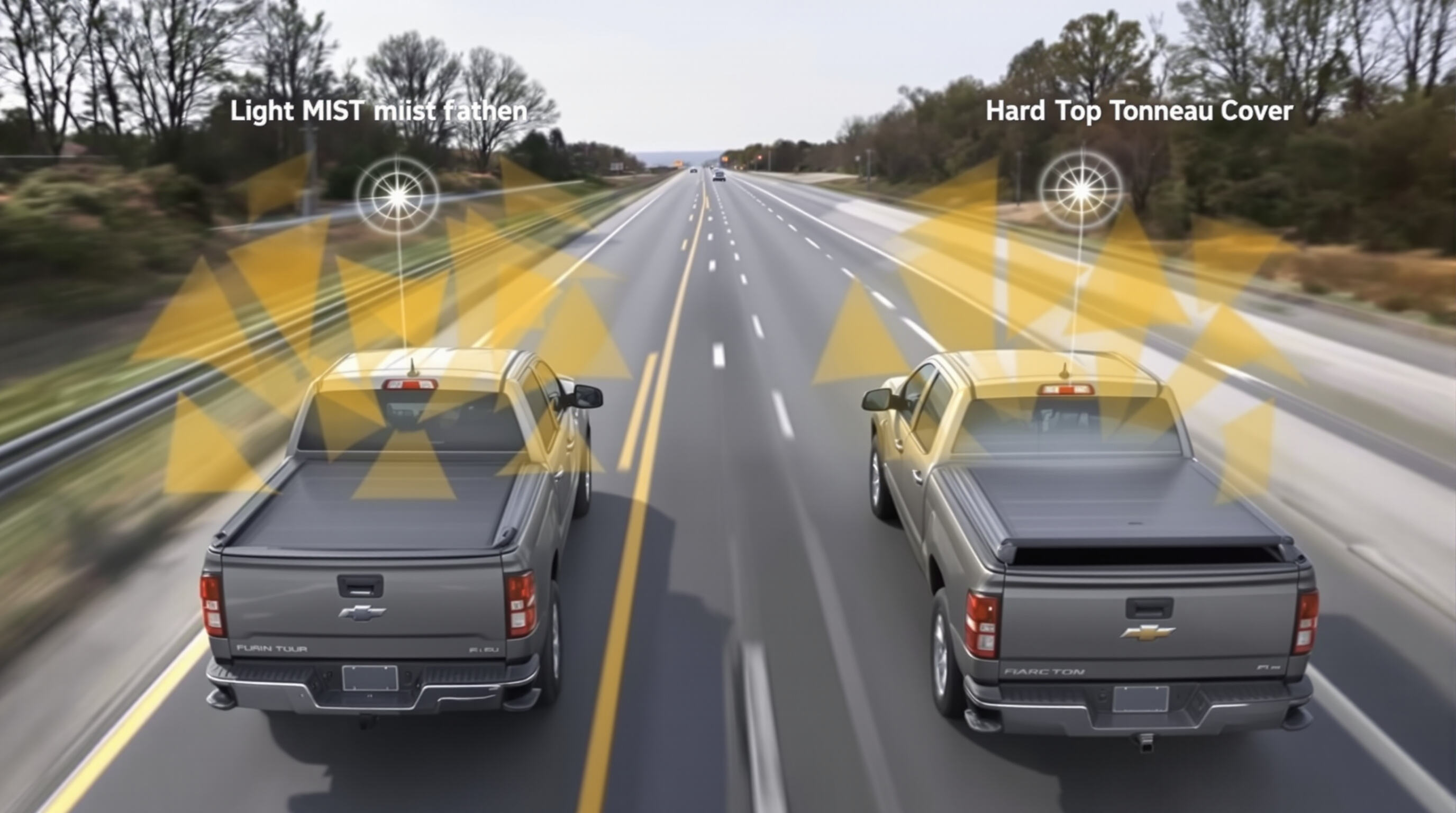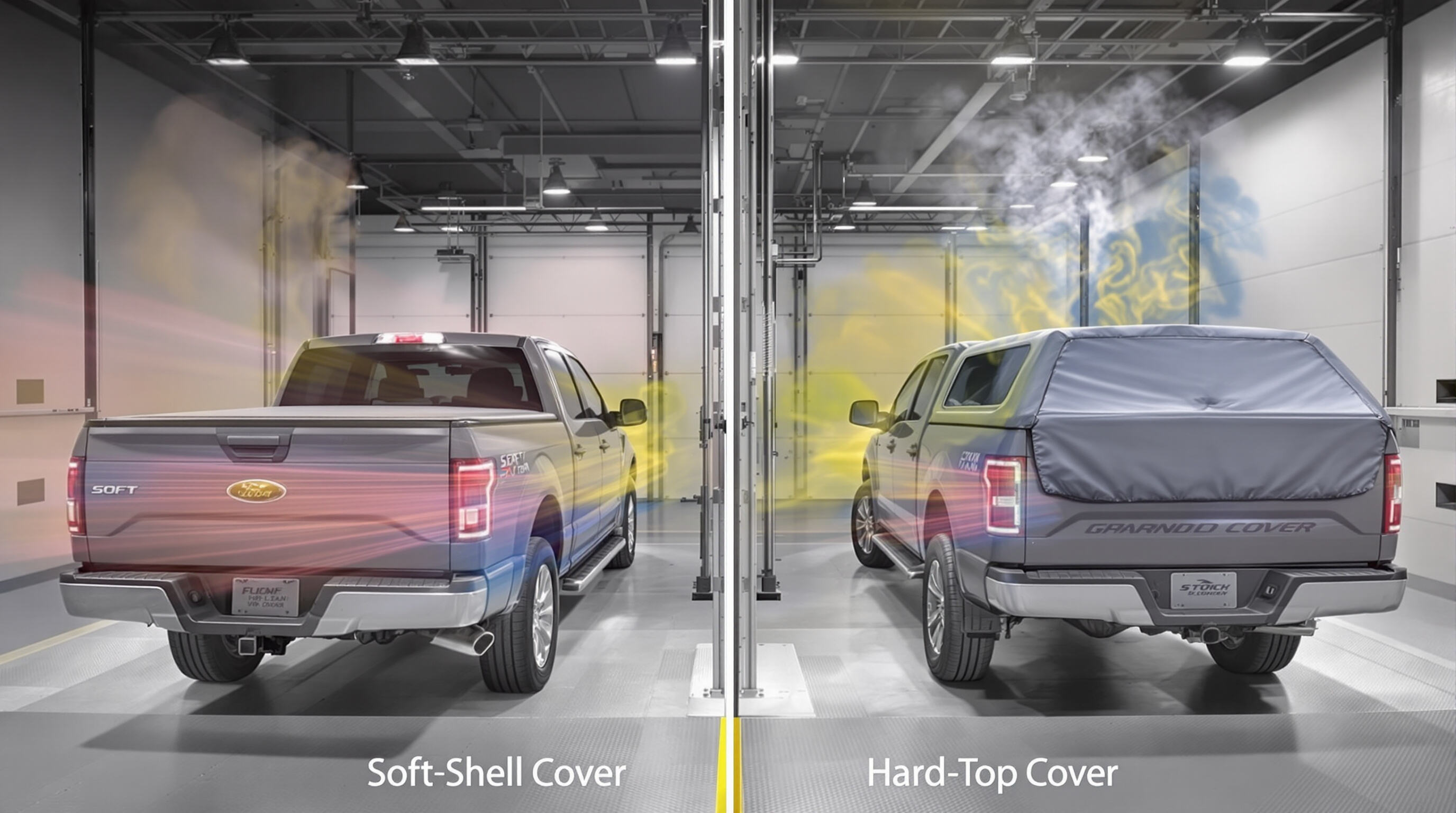How Tonneau Covers Improve Aerodynamics and Reduce Drag

The Role of Drag Coefficient in Pickup Truck Fuel Efficiency
A pickup truck's drag coefficient (Cd) directly impacts fuel efficiency. Every 10% reduction in Cd improves highway fuel economy by approximately 5%. Open truck beds typically have Cd values between 0.4–0.6—significantly higher than fully enclosed vehicles, which range from 0.3 to 0.35.
How Open Truck Beds Increase Wind Resistance
Uncovered truck beds disrupt airflow, creating a low-pressure vortex inside the bed at highway speeds. This pressure drag increases aerodynamic resistance, forcing engines to work 12–17% harder than they would with a covered bed.
Tonneau Covers and Their Influence on Airflow Dynamics
Hard-top tonneau covers streamline airflow over the truck bed, reducing turbulence by 34–52% in computational fluid dynamics (CFD) simulations. Soft-shell models reduce turbulence by 22–31%. Both promote a more laminar flow, minimizing energy-wasting eddies behind the cab.
Quantifying Aerodynamic Improvements: CFD Studies and Wind Tunnel Data
Recent wind tunnel tests show:
| Cover Type | Drag Reduction | Fuel Efficiency Gain* |
|---|---|---|
| Hard-Folding | 8.9% | 2.1% |
| Soft-Roll-Up | 6.3% | 1.5% |
| Retractable | 9.7% | 2.3% |
*At 65 MPH sustained speed (SAE J1252 test protocol). Results vary by truck bed length and cab configuration.
Real-World Fuel Efficiency Gains with Tonneau Covers
Comparison of Fuel Economy Before and After Tonneau Cover Installation
Back in 1997, SEMA did some research on this stuff and discovered that putting tonneau covers on pickup trucks actually cut down drag by around 11.8%. That translated into better gas mileage too, giving drivers about a 1.8 MPG boost when cruising on highways, so going from roughly 16 to 17.8 MPG. Then again in 2007 they checked things out further and saw similar results, with different kinds of covers still reducing drag by at least 6.5%. Looking at what's happening now in the industry, most data points to fuel savings somewhere between 1% and 2% once these covers get installed. Pretty decent improvement for something that doesn't cost much money upfront.
Real-World Fuel Efficiency Improvements with Tonneau Covers
Aerodynamic improvements really kick in when trucks hit speeds over 55 mph on the highway, as tonneau covers help smooth out the air flowing across the truck bed area. For someone who drives around 10k miles on highways each year, these covers can save anywhere from $150 to $300 worth of gas annually. That kind of saving usually pays for a decent quality cover in about two or three years. People who spend most of their time cruising down interstates tend to get roughly 78 percent better value from these covers compared to folks stuck in city traffic all day long.
Variability of Fuel Savings Based on Truck Model and Configuration
| Factor | Impact on Fuel Efficiency |
|---|---|
| Bed length | Longer beds (8'+) see 23% greater drag reduction |
| Cab style | Crew cab models benefit 12% more than regular cabs |
| Cover type | Hard-folding covers outperform soft roll-ups by 0.4 MPG |
Full-size trucks generally achieve 40% higher fuel savings compared to mid-size models due to their larger surface area and air displacement.
Highway vs. City Driving: When Tonneau Covers Deliver the Most Benefit
Fuel Savings from Using Tonneau Covers on Highways
Tonneau covers deliver the greatest efficiency gains during steady highway driving. At speeds above 55 mph, uncovered beds increase drag by 15–20% (SAE International 2022). By smoothing airflow, hard-shell covers improve highway fuel economy by 5–7% in full-size pickups, according to a 2023 vehicle aerodynamics study.
Why Tonneau Covers Have Limited Impact in City Driving Conditions
In stop-and-go city traffic, where speeds rarely exceed 45 mph, aerodynamic drag accounts for less than 10% of total energy consumption. Frequent acceleration and deceleration diminish the impact of drag reduction, resulting in only 0.5–1.2% fuel economy improvements in urban driving cycles.
Speed Thresholds for Noticeable Aerodynamic Benefits
Measurable fuel savings begin at 45–50 mph, but most drivers experience significant benefits above 65 mph. Because drag increases with the cube of speed, every 10 mph increase beyond 50 mph triples the fuel-saving effect of a tonneau cover.
Soft-Shell vs. Hard-Top Tonneau Covers: Which Is More Efficient?

Aerodynamic Performance of Soft-Shell Tonneau Covers
Soft shell covers usually come in materials like heavy duty vinyl or canvas and tend to lay pretty flat across the truck bed area. Wind tunnel testing shows they cut down on drag somewhere between 5% to maybe 10%. These covers don't really add much extra weight to the vehicle, though sometimes they flutter around at high speeds which messes with the air flow pattern. They are cheap enough to buy and simple to put on most trucks, but because of how flexible they are, they just cant match the aerodynamics of something more solid and rigid in construction.
Advantages of Hard-Top Covers in Reducing Drag Coefficient
Tonneau covers made of aluminum or fiberglass can cut down wind resistance by around 15% according to computer modeling tests. The smooth surface of these hard tops helps keep air flowing properly when going fast, which stops turbulence that wastes gas. Most models come with sloped edges and flat closing mechanisms designed specifically for better airflow around the truck bed. Drivers who spend time on highways often notice real improvements in gas mileage over long trips, especially when carrying cargo that might otherwise disrupt the natural flow of air past the vehicle.
Sealing Efficiency and Its Impact on Wind Resistance in Pickup Trucks
When there are spaces between a truck cover and the actual bed, these openings create swirling air patterns called vortices that actually slow things down by increasing resistance. Most hard top designs come equipped with special compression seals or those EPDM rubber gaskets we hear so much about lately. These components reportedly cut down on air escaping through gaps by around 90%, based on tests conducted by organizations like SAE International. On the other hand, soft tonneau covers typically depend on tension clamps for securing them in place. Unfortunately, this setup sometimes leaves small spaces along the sides of the truck bed when facing strong crosswinds. The better seal provided by hard tops is probably why they tend to reduce wind resistance by somewhere between 20 and 30 percent compared to their softer counterparts during windy conditions. Of course, actual results might vary depending on specific model features and how well everything fits together.
Case Study: Fuel Economy Comparison Across Cover Types
A 2023 study compared three tonneau cover types on identical pickup trucks during a 1,000-mile mixed driving cycle:
| Cover Type | Avg. MPG Improvement | Highway Benefit | City Benefit |
|---|---|---|---|
| Soft Roll-Up | 2.1% | 3.4% | 0.8% |
| Hard Folding | 3.8% | 5.2% | 1.1% |
| Retractable Hard | 4.3% | 6.1% | 1.3% |
Rigid designs consistently outperform soft covers, especially at speeds above 55 mph where aerodynamic forces dominate fuel consumption.
FAQ
What is the purpose of a tonneau cover?
A tonneau cover streamlines airflow over a truck bed, reducing aerodynamic drag and improving fuel efficiency, especially during highway driving.
How much can a tonneau cover improve fuel efficiency?
Depending on the type, a tonneau cover can improve fuel efficiency by approximately 1% to 2% on average, with hard-top versions generally offering greater savings.
Do all types of tonneau covers offer the same level of aerodynamics?
No, hard-top tonneau covers typically provide better aerodynamic improvements compared to soft-shell versions, especially at higher speeds.
Is it worth investing in a tonneau cover for city driving?
The benefits are more noticeable during highway driving due to higher speeds, but some savings can still be achieved in city traffic, typically less than 1.2% in fuel economy improvements.

